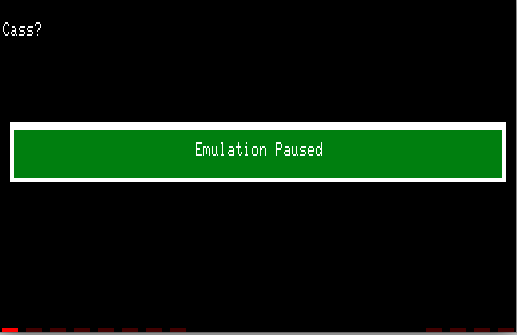
Features
Introduction Features Options Text GUI OS X Features Known Bugs Release History Credits
 |
SDLTRS Help Features Introduction Features Options Text GUI OS X Features Known Bugs Release History Credits |
| Host Key |
Function |
| F1 |
TRS-80 Model 4/4P F1 key (address bit 7, data
bits 4) TRS-80 Model 1 Electric Pencil control key |
| F2 |
TRS-80 Model 4/4P F2 key (address bit 7, data bits 5) |
| F3 |
TRS-80 Model 4/4P F3 key (address bit 7, data bits 6) |
| F4 |
TRS-80 Model 4 Caps Lock key (address bit 7, data bit 3) |
| F5 or ScrollLock |
TRS-80 @ key |
| F6 |
TRS-80 '0' key (so that a shifted 0 can be obtained) |
| F7 |
Enter Text GUI (only in Fullscreen mode on Mac OS X) |
| F8 |
Exit SDLTRS |
| F9 |
Enter the debugger (zbx) |
| F10 |
Warm Reset |
| Shift F10 |
Power on Reset (reboot) |
| ESC |
Break |
| Left Arrow or Backspace or Delete |
TRS-80 left arrow key |
| Right Arrow or Tab |
TRS-80 right arrow key |
| Up Arrow |
TRS-80 up arrow key (caret for exponent) |
| Down Arrow |
TRS-80 down arrow key |
| Home or Clear |
TRS-80 clear key |
| Control |
TRS-80 Model 4 Ctrl key (address bit 7, data bit 2) |
| RightAlt (or RightCmd on the Mac) |
TRS-80 shifted down arrow key (used as a control key with some TRS-80 software) |
| Page Up |
TRS-80 Left Shift key (address bit 7, data bit 0) |
| Page Down |
TRS-80 Right Shift key (address bit 7, data bit 1) |
| End Key |
TRS-80 Unused key (address bit 7, data bit 7) |
| Insert Key |
TRS-80 Underscore key (address bit 3, data bit 7) |
| Shift UP Arrow |
TRS-80 ESC key |
| Ctrl + c (or LeftCmd + c on the Mac) |
Copy from TRS-80 to host |
| Ctrl + v (or LeftCmd + v on the Mac) |
Paste from TRS-80 to host |
| Ctrl + a (or LeftCmd + a on the Mac) |
Select All on TRS-80 screen |
| LeftAlt + '=' (think +) (or Left Cmd + '=' |
Set windowed mode scaling to next higher size. (1x, 2x, 3x, and then wraps). |
| LeftAlt + '-' (or Left Cmd + '-' on the Mac) |
Set windowed mode scaling to next lower size. (3x, 2x, 1x and then wraps). |
| LeftAlt + Enter (or LeftCmd + Enter on the Mac) |
Switch from Windowed to Fullscreen mode and back. |
| Alt + d (or LeftCmd + d on the Mac) |
Enter Floppy Disk Management GUI |
| Shift + Alt + d (or Shift + LeftCmd + d on the Mac) |
Enter Hard Disk Management GUI |
| Alt + t (or LeftCmd + t on the Mac) |
Enter Cassette ('t' for Tape) Management GUI |
| Alt + s (or LeftCmd + s on the Mac) |
Save Emulator State |
| Alt + l (or LeftCmd + l on the Mac) |
Load Emulator State |
| Alt + w (or LeftCmd + t on the Mac) |
Write Configuration File |
| Alt + r (or LeftCmd + t on the Mac) |
Read Configuration File |
| Alt + p (or LeftCmd + p on the Mac) |
Pause Emulator (and then unpause) |
| Alt + 1 (or 2,3,4,5,6,7,8) (or LeftCmd + 1 on the Mac) |
Insert Floppy disk into drive N |
| Shift + Alt + 1 (or 2,3,4,5,6,7,8) (or Shift + LeftCmd + 1 on the Mac) |
Remove Floppy disk from drive N |

